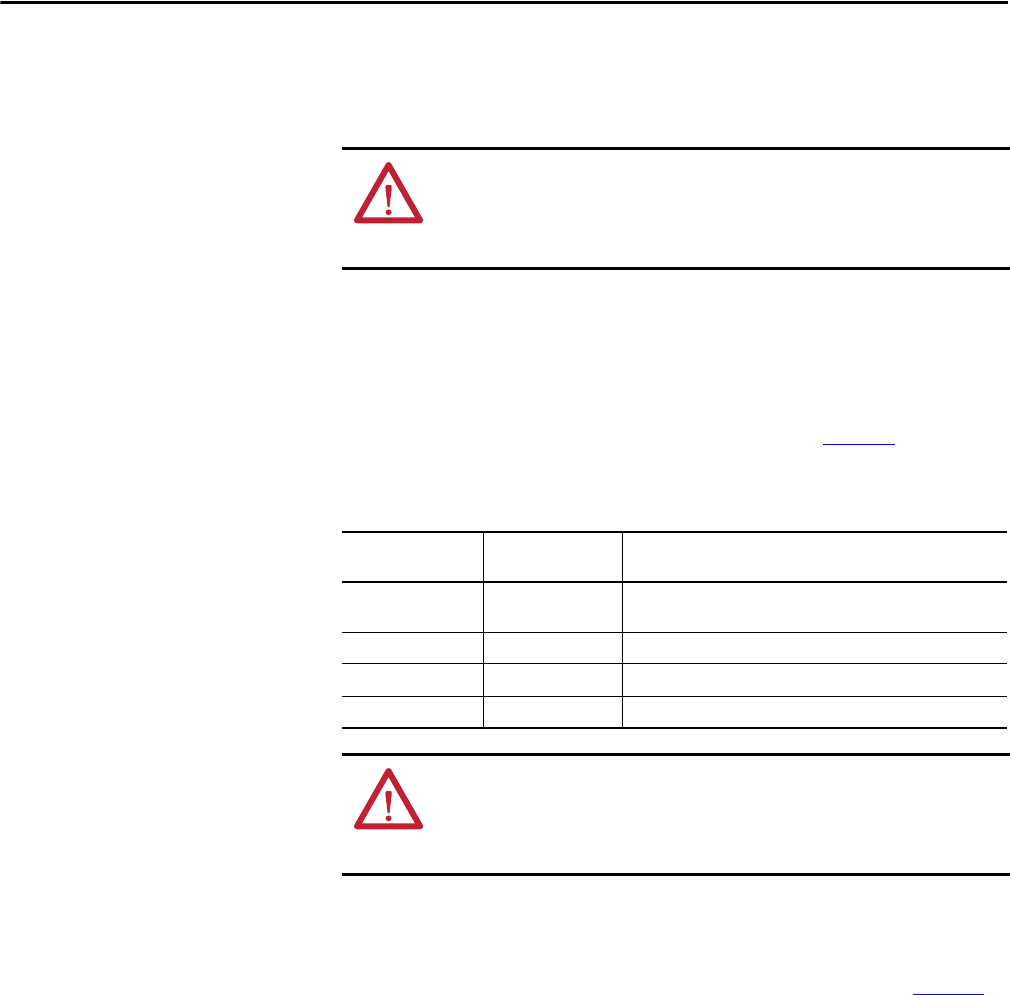Owner's manual
Table Of Contents
- Front Cover
- Important User Information
- Summary of Changes
- Table of Contents
- Introduction
- About the Drive
- Identifying the Drive by Cabinet Assembly ID Number
- LiquiFlo 2.0 Drive Component Locations
- Identifying the Power Module by Model Number
- AC Line I/O Board Description (Frame 3 Only)
- Standard I/O Board Description (Frame 3 Only)
- Combined I/O Board Description (Frame 4 Only)
- DPI Communication Ports
- Optional Equipment
- Planning the Installation
- Mounting The Power Module and Grounding the Drive
- Installing Input and Output Power Wiring
- Completing the Installation
- Using the Start-up Routines
- Programming Basics
- Parameter Descriptions
- Troubleshooting the Drive
- Verify that the DC Bus Capacitors are Discharged Before Servicing the Drive
- Determining Drive Status Using the Status LEDs
- About Alarms
- About Faults
- Diagnostic Parameters
- Common Symptoms and Corrective Actions
- Replacement Parts
- Board Replacement, Firmware Setup Procedures
- Troubleshooting the Drive Using the OIM
- Checking the Power Modules with Input Power Off
- Technical Specifications
- Using the OIM
- Installing and Removing the OIM
- Display Description
- OIM Menu Structure
- Powering Up and Adjusting the OIM
- Selecting a Device in the System
- Using the OIM to Program the Drive
- Monitoring the Drive Using the Process Display Screen on the OIM
- Displaying and Changing the OIM Reference
- Customizing the Process Display Screen
- Customizing the Function Keys
- Controlling the Drive From the OIM
- LiquiFlo 2.0 Drive Frame 3 Wiring Diagrams
- LiquiFlo 2.0 Drive Frame 4 Wiring Diagrams
- Index
- Back Cover

Rockwell Automation Publication D2-3518-3 - May 2013 155
Chapter 9
10 = Jog: An open-to-closed transition on this input while the drive is stopped
causes the drive to start (jog) in the current direction. When the input opens
while the drive is running (jogging), the drive stops.
The drive does not jog while running or while the Stop - Clear Faults input is
open. Start has precedence over jog.
11 and 12 = Jog Forward and Jog Reverse: An open-to-closed transition on one
or both inputs while the drive is stopped causes the drive to jog unless the
Stop - Clear Faults input function is configured and open. Ta bl e 11
describes the
actions taken by the drive in response to various states of these input functions.
Table 11 - Drive Response to Jog Forward and Jog Reverse Inputs
The drive will not jog while running or while the Stop - Clear Faults input is
open. Start has precedence over jog.
If one of these input functions is configured and the other one is not, Ta b le 1 1
still applies, but consider the unconfigured input function permanently open.
13 = Stop Mode B: This digital input selects between two different drive stop
modes.
If the input is open, then Stop Mode A selects which stop mode to use. If the
input is closed, the Stop Mode B selects which stop mode to use. If this input
function is not configured, then Stop Mode A selects which stop mode to use.
14 = Bus Regulation Mode B: This digital input function selects how the drive
regulates excess voltage on the DC bus.
If the input is open, then Bus Reg Mode A selects which bus regulation mode to
use. If the input is closed, then Bus Reg Mode B selects which bus regulation
ATTENTION: If a normal drive start command is received while the drive is
jogging, the drive switches from jog mode to run mode. The drive does not stop,
but may change speed and/or change direction. Failure to observe this
precaution could result in severe bodily injury or loss of life.
Jog
Forward
Jog
Reverse
Drive Response
Open Open Drive will stop if already jogging, but can be started by other
means.
Open Closed Drive jogs in reverse direction.
Closed Open Drive jogs in forward direction.
Closed Closed Drive continues to jog in current direction.
ATTENTION: If a normal drive start command is received while the drive is
jogging, the drive will switch from jog mode to run mode. The drive will not
stop, but may change speed and/or change direction. Failure to observe this
precaution could result in severe bodily injury or loss of life.










